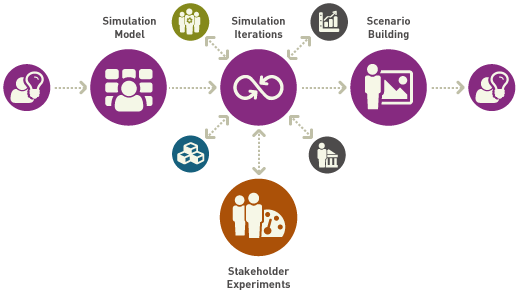SI Baviour Scenarios
Background
In line with its interdisciplinary and innovative approach, SIMPACT will make use of advanced methods in economics. In terms of foresight, simulation and scenario building supports social innovation stakeholders in coping with innovation-related uncertainties. These methods contribute to understanding the various factors influencing the evolutionary process of social innovation and defining favourable conditions by considering alternative development paths and outcomes of social innovation. However, traditional econometric and innovation models have not provided a comprehensive perspective that integrates
- 1 social, economic and environmental concerns;
- 2 heterogeneous agents' behaviours, roles and relationships.
Building a quantitative model with a focus on the interactions in the social innovation system is crucially important to reduce complexity to an extent that allows for guiding our thinking and providing an idea how certain changes in the system would affect its dynamics and outcome.
Objectives
The overall objective is to test and verify the findings, concepts, models and instruments developed throughout the project by simulating different scenarios of how social innovation works in an economic «efficient» way. To this end agent-based modelling is applied and - with the aim going beyond theoretical models - complementary small-scale Go to Dialoguestakeholder experiments will be carried out.
Methodology
Given a strong focus on the heterogeneity of stakeholders (agents) in the social innovation system as well as the importance and complexity of interaction between stakeholders, an agent-based modelling (ABM) approach will be used to model and test the economic dimensions of social innovation elaborated during the project term. Rarely applied to social innovation, ABM is a promising method for studying innovation processes and capturing economic complexities including micro-foundations and macro-outcomes. The models will characterise agents, environments, decision rules and dynamic interaction processes. Moreover, the behaviours of specific social innovation stakeholders will be modelled in ways which reflect the emergence of those tendencies from the interactions between individuals.

ABM will therefore allow us to specify a certain set of assumptions about reality and to predict the outputs to which they lead. In this way we can help understand how public policy can facilitate social innovation and how social innovation can work successfully. To go beyond modelling and integrate social innovation reality, participatory action research in form of stakeholder experiments will involve intermediaries representing the target groups, policy makers and innovators in modelling and testing.
Basic Information
-
Coordinator
CEPS -
Contact
Miroslav BEBLAVY -
Involved Partners
TUDO, CIS, TNO -
Start Date
07/2014
Glossary
- 1
Agend-based Modelling (AMB)
ABM is a method which begins with assumptions about agents (SI stakeholders) and their interactions and then uses computer simulation to generate «histories» that can reveal the dynamic consequences of these assumptions.
- 2
Scenario
Scenarios are narrative descriptions («stories») of potential futures that focus on relationships between events and decision points. They direct attention to driving forces, possible avenues of evolution and the span of contingencies that may be confronted. Thus they are particularly useful when many factors need to be considered and the degree of uncertainty about the future is high. Scenario building can be used as a tool for decision-making, mainly to highlight the discontinuities from the present and to reveal the choices available and their potential consequences.












